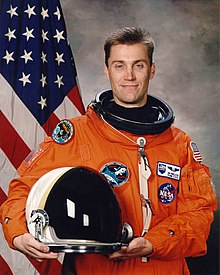
John Howard Casper is a former American astronaut and retired United States Air Force pilot.

Robert Brent "Bob" Thirsk, is a Canadian retired engineer and physician, and a former Canadian Space Agency astronaut. He holds the Canadian record for the most time spent in space. He became an officer of the Order of Canada (OC) in 2013 and was named to the Order of British Columbia (OBC) in 2012.

David Alexander Wolf is an American astronaut, medical doctor and electrical engineer. Wolf has been to space four times. Three of his spaceflights were short-duration Space Shuttle missions, the first of which was STS-58 in 1993, and his most recent spaceflight was STS-127 in 2009. Wolf also took part in a long-duration mission aboard the Russian space station Mir which lasted 128 days, and occurred during Mir EO-24. He was brought to Mir aboard STS-86 in September 1997, and landed aboard STS-89 in January 1998. In total Wolf has logged more than 4,040 hours in space. He is also a veteran of 7 spacewalks totaling 41hrs 17min in both Russian and American spacesuits.

Richard Noel "Dick" Richards, , is a retired American naval officer and aviator, test pilot, chemical engineer, and a former NASA astronaut. He flew aboard four Space Shuttle missions in the 1980s and 1990s.

STS-58 was a NASA mission flown by Space Shuttle Columbia launched from Kennedy Space Center, Florida, on October 18, 1993. The missions was primarily devoted to experiments concerning the physiological effects in space. This was the first in-flight use of the "Portable In-flight Landing Operations Trainer" (PILOT) simulation software. It was also the last time Columbia would land at Edwards Air Force Base, California.

Norman Earl Thagard, is an American scientist and former U.S. Marine Corps officer and naval aviator and NASA astronaut. He is the first American to ride to space on board a Russian vehicle, and can be considered the first American cosmonaut. He did this on March 14, 1995, in the Soyuz TM-21 spacecraft for the Russian Mir-18 mission.

William Edgar Thornton was an American NASA astronaut. He received a Bachelor of Science degree in physics from University of North Carolina and a doctorate in medicine, also from UNC. He flew on Challenger twice, the STS-8 and STS-51-B missions.

STS-69 was a Space Shuttle Endeavour mission, and the second flight of the Wake Shield Facility (WSF). The mission launched from Kennedy Space Center, Florida on 7 September 1995. It was the 100th successful crewed NASA spaceflight, not including X-15 flights.

STS-90 was a 1998 Space Shuttle mission flown by the Space Shuttle Columbia. The 16-day mission marked the last flight of the European Space Agency's Spacelab laboratory module, which had first flown on Columbia on STS-9, and was also the last daytime landing for Columbia.

Jeffrey Alan Hoffman is an American former NASA astronaut and currently a professor of aeronautics and astronautics at MIT.

Roger Keith Crouch is an American scientist and astronaut who flew as a payload specialist on two NASA Space Shuttle missions in 1997.

Lawrence James DeLucas is an American biochemist who flew aboard NASA Space Shuttle mission STS-50 as a Payload Specialist. He was born on July 11, 1950, in Syracuse, New York, and is currently married with three children. His recreational interests include basketball, scuba diving, bowling, model airplanes, astronomy and reading.

Jean-Jacques Favier was a German-born French engineer and a CNES astronaut who flew aboard the STS-78 NASA Space Shuttle mission in 1996. Favier was due to fly aboard the doomed Columbia mission in 2003 (STS-107), but later opted out of the mission. Jean-Jacques Favier was deputy director for space technology and deputy director for advanced concepts and strategy at CNES, director of the Solidification Laboratory at the French Atomic Energy Commission and research program director at the International Space University.

Francis Andrew "Drew" Gaffney is an American doctor and former astronaut. He previously worked for NASA and participated in the STS-40 Space Life Sciences Space Shuttle mission in 1991 as a payload specialist.

Kathryn Patricia "Kay" Hire is a former NASA astronaut and Captain in the U.S. Navy Reserve who has flown aboard two Space Shuttle missions.

Millie Elizabeth Hughes-Fulford was an American medical investigator, molecular biologist, and payload specialist who flew aboard the NASA Space Shuttle Columbia in June 1991.

Richard Michael Linnehan is a United States Army veterinarian and a NASA astronaut.

Fred Weldon Leslie is an American scientist who flew on the NASA STS-73 Space Shuttle mission as a payload specialist.

Chiaki Mukai is a Japanese physician and JAXA astronaut. She was the first Japanese woman in space, the first Japanese citizen to have two spaceflights, and the first Asian woman in space. Both were Space Shuttle missions; her first was STS-65 aboard Space Shuttle Columbia in July 1994, which was a Spacelab mission. Her second spaceflight was STS-95 aboard Space Shuttle Discovery in 1998. In total she has spent 23 days in space.

Jay Clark Buckey, Jr. is an American physician and astronaut who flew aboard one Space Shuttle mission (STS-90) as a Payload Specialist. Buckey briefly ran for the Democratic nomination to challenge New Hampshire Senator John E. Sununu, a first term Republican, when he was up for re-election in 2008. Buckey withdrew from the race when former Governor Jeanne Shaheen entered the race.




















